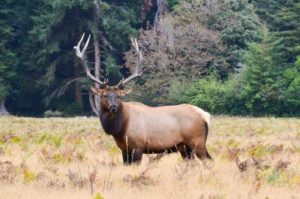 Breeding season, Daylight Savings Time, and snowfall at lower elevations have led to high numbers of wildlife-vehicle collisions. In November, deer, moose, elk, and bighorn sheep are on the move during migration and mating season. Drivers must be particularly vigilant during this season. Daylight Savings Time means drivers are returning home at dusk, the time of day when wildlife is on the move.
Breeding season, Daylight Savings Time, and snowfall at lower elevations have led to high numbers of wildlife-vehicle collisions. In November, deer, moose, elk, and bighorn sheep are on the move during migration and mating season. Drivers must be particularly vigilant during this season. Daylight Savings Time means drivers are returning home at dusk, the time of day when wildlife is on the move.
How to Avoid a Collision with Wildlife
While there is no 100% way to avoid a collision with an animal that suddenly enters the roadway, you can reduce your risk by taking certain actions, including:
- Reduce your speed. If you drive a little slower, you can more easily see animals moving at the side of the road and respond by slowing down to avoid an impact.
- Scan the roadside as you approach. In many cases, animals about to cross the road are visible. When driving, scan the side of the road or highway to spot any movement or eye-shine from animals in the trees or brush.
- Slow down at animal crossing warning signs. Deer, elk, and other animals travel the same routes every year. Slow your vehicle when you see a warning sign.
- If you see one animal, expect more. Once a deer, elk, bighorn sheep, or other type of wildlife has crossed the road, expect that others will follow.
- Avoid swerving if an animal is in front of you. If you swerve to try to avoid hitting wildlife, you could cause a serious head-on or sideswipe collision. Use your brakes.
- Do not tailgate. Should a driver ahead of you encounter an animal on the road, they will jam on the brakes. Leave more room between the vehicle ahead, as following too closely can lead to a rear-end collision that could have been avoided.
- Use your brights. If no other vehicles are in the oncoming lane, use your high beams.
- Use the center lane. If you have two lanes, take the center lane so you have more time to respond and come to a stop should wildlife enter the road.
- Use the horn. You may encounter an animal on or near the road. Flash your lights and honk your horn to scare the animal off, with the added benefit of alerting other drivers nearby.
After a Collision – What to Do?
If you have had the bad luck to collide with deer, elk, moose, bighorn sheep, or another type of wildlife, your vehicle may have been seriously damaged, and you or your passengers may have suffered injuries A large animal, when hit by a vehicle, often is thrown onto the hood, and through the windshield. If a collision is inevitable, lean towards the side of your vehicle, not the center, to protect your body should the animal break or even come through the windshield.
A wildlife/vehicle collision may have led to a multi-vehicle accident. The actions of each driver involved in the collision must be evaluated in determining liability. If only your vehicle was involved, your auto insurance should cover the cost of repairing your vehicle, based on the type of coverage you purchased.
When other drivers were involved in an accident, and injuries were sustained, the legal situation is far more complex. Take these steps:
- If any person is injured, contact emergency services immediately.
- If possible, take pictures of the accident scene with your phone.
- Obtain contact information of others involved in the collision.
- Ensure you undergo a full medical evaluation and tell the doctor you were involved in a collision.
- Contact a talented, experienced personal injury lawyer to manage your case, and who will pursue the maximum in compensation.
- Do not make a recorded statement without legal counsel to guide you.
Contact Welsh Law, LLC at (720) 836-1777 for a free consultation after a wildlife/vehicle accident.
